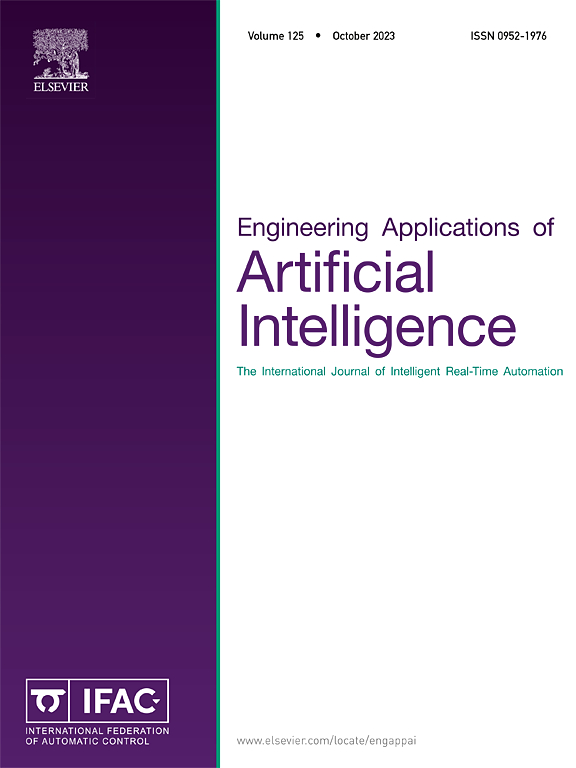A lightweight algorithm for wildlife detection in outdoor environments based on you only look once version 8 network
IF 8
2区 计算机科学
Q1 AUTOMATION & CONTROL SYSTEMS
Engineering Applications of Artificial Intelligence
Pub Date : 2025-07-02
DOI:10.1016/j.engappai.2025.111544
引用次数: 0
Abstract
To address the challenges posed by outdoor environments, such as obstructions, background noise, and the limited computational resources of detection devices that hinder accurate wildlife detection, we propose a lightweight wildlife detection algorithm named Wildlife-You Only Look Once (WL-YOLO). First, the High-level Screening-feature Pyramid Networks (HS-FPN) is introduced to enhance the processing of multi-scale wildlife features. This architecture captures comprehensive feature information while significantly reducing computational complexity. Next, the Depthwise Adaptive Spatial Attention (DASA) module is designed to improve the adaptability of the model to various environmental backgrounds, effectively addressing challenges such as object occlusion and complex backgrounds in wildlife images. Additionally, the Scylla Intersection over Union (SIoU) loss is utilized to optimize detection accuracy. Finally, a pruning method based on layer-adaptive magnitude-based pruning (LAMP) is applied to the model to trim redundant parameters. Experimental results indicate that WL-YOLO achieves comparable detection accuracy to the original YOLO model (version 8) while reducing parameters by 66.7% and computational load by 57.5%. It processes images at a speed of 344 frames per second. Furthermore, detection results indicate that WL-YOLO performs better in handling occlusions and complex environments. Compared to mainstream object detection algorithms, WL-YOLO achieves a favorable balance among detection accuracy, inference speed, and model complexity. The research suggests that WL-YOLO is better applicable in complex outdoor environments, offering a new pathway for research on wildlife diversity. The code will be available on GitHub (https://github.com/xust-9527/WL-YOLO).

一个轻量级的算法,野生动物检测在户外环境中基于你只看一次版本8网络
为了解决室外环境(如障碍物、背景噪声和检测设备有限的计算资源)阻碍准确检测野生动物的挑战,我们提出了一种轻量级的野生动物检测算法,名为wildlife - you Only Look Once (WL-YOLO)。首先,引入高级筛选特征金字塔网络(HS-FPN)来增强多尺度野生动物特征的处理。该体系结构捕获了全面的特征信息,同时显著降低了计算复杂度。其次,设计深度自适应空间注意(deep thwise Adaptive Spatial Attention, DASA)模块,提高模型对各种环境背景的适应能力,有效解决野生动物图像中物体遮挡和复杂背景等问题。此外,Scylla十字路口联合(SIoU)损耗被用来优化检测精度。最后,将基于层自适应幅度的剪枝方法(LAMP)应用于模型,对冗余参数进行剪枝。实验结果表明,WL-YOLO的检测精度与原始YOLO模型(version 8)相当,同时减少了66.7%的参数和57.5%的计算量。它以每秒344帧的速度处理图像。此外,检测结果表明WL-YOLO在处理闭塞和复杂环境方面具有更好的性能。与主流目标检测算法相比,WL-YOLO在检测精度、推理速度和模型复杂度之间取得了较好的平衡。研究表明WL-YOLO在复杂的室外环境中具有更好的适用性,为野生动物多样性研究提供了新的途径。代码将在GitHub (https://github.com/xust-9527/WL-YOLO)上提供。
本文章由计算机程序翻译,如有差异,请以英文原文为准。
求助全文
约1分钟内获得全文
求助全文
来源期刊

Engineering Applications of Artificial Intelligence
工程技术-工程:电子与电气
CiteScore
9.60
自引率
10.00%
发文量
505
审稿时长
68 days
期刊介绍:
Artificial Intelligence (AI) is pivotal in driving the fourth industrial revolution, witnessing remarkable advancements across various machine learning methodologies. AI techniques have become indispensable tools for practicing engineers, enabling them to tackle previously insurmountable challenges. Engineering Applications of Artificial Intelligence serves as a global platform for the swift dissemination of research elucidating the practical application of AI methods across all engineering disciplines. Submitted papers are expected to present novel aspects of AI utilized in real-world engineering applications, validated using publicly available datasets to ensure the replicability of research outcomes. Join us in exploring the transformative potential of AI in engineering.
 求助内容:
求助内容: 应助结果提醒方式:
应助结果提醒方式:


